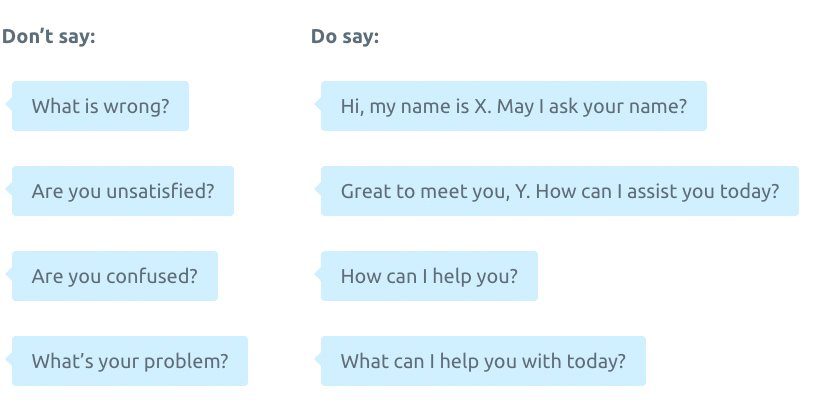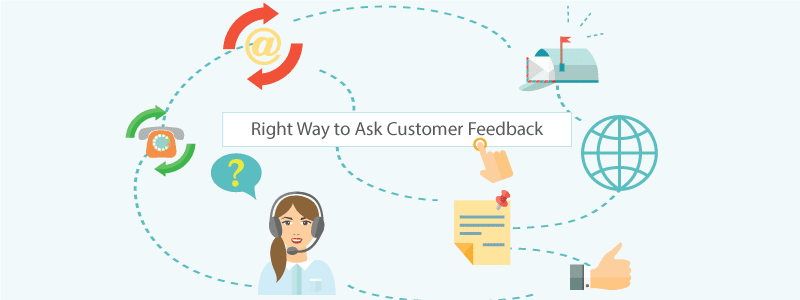In this blog post, we will dive deep into the best practices for providing chat support.
The functionality of customer support technologies such as voice, email, and live chat must allow agents to respond in an appropriate, timely, and accurate manner. When responding to a live chat, agents must use the same personality, responsiveness, and accuracy as voice support, and respond with the depth of detail of email support. Teaching and learning ‘verbal charisma’ can be a challenging task—for agents and managers!
The following best practices are meant to help you build, train, and manage a personable, successful live chat team who delivers exceptional customer care and support.
1. Avoid Acting Robotic
Using a live chat service is a promise—a promise that an actual person will be on hand and ready to address your client’s customers’ concerns in real-time. If customers expect an authentic experience and an automated chatbot greets them instead, chances are they will end the interaction. If the customer cannot resolve the issue on his own or with another support method, the customer may not become a return customer.
Chatbots can be used effectively and perform well when used appropriately. Live chat offers interaction with human agents, providing customers key nuances such as personality, flexibility, and responsiveness that chatbots may not replicate well. Canned responses and robotic replies have potential to drive away your customers who want help from a genuine personal interaction.
2. Use Canned Messages Responsibly
Canned or template messages are appropriate for certain elements of live chat support, but agents should refrain from using them for full-support interactions. Often, customers will have issues not covered in the standard documentation. Configured messages may not solve their problem and can create great frustration. Templates are useful for introductions and data gathering, after which the agents should fall back on their training and knowledge to solve unique problems authentically.
3. Emphasize Tailored Training
Learning about your client’s products is essential for all agents regardless of support method. Training that goes beyond the basics gives agents the ability to become a natural extension of your client. Understanding your client’s company culture is valuable for agents and provides authenticity customers desire and deserve. The best live chat support comes from agents who embody the same company standards and work culture of your client. Tailored training that offers a deeper product, service, and institutional knowledge results in quicker response times, increases customer engagement, and becomes a vital asset for your live chat support team.
4. Acknowledge and Empathize with Customer Issues
One of the primary qualities of successful live chat support is acknowledging the issue as soon as possible, then empathizing with the customer who has reached out. Agents can learn empathy by being sensitive to each customer’s needs. When your agents care about the customers’ problems, they will work diligently to solve them as best they can.
“I’m constantly blown away at how appreciative people are when they get human replies. Years of uncaring or even hostile support experiences have set the bar low for their expectations that they get excited by genuine answers.” – Micah Bennett, Zapier
Using specific language, such as “I’m sorry this is happening. Can you give me more details about X?” conveys empathy while proactively gathering information to proceed. When troubleshooting, your agents should recognize steps the customer has already taken and apologize for repeating them if it’s necessary to find the issue’s root cause. Vague answers from disinterested agents diminish genuine live chat engagement.
5. Strive to Present a Positive Attitude
Unfailing positivity is a key quality to any live chat conversation. Your agent’s language should convey positivity without overdoing it, such as using excessive exclamation points or over-the-top responses. Picking the right style of positive communication may require some individualized training and experience, but it’s a desired trait in live chat support. Work one-on-one with agents as time allows to help them adapt a positive attitude.

(Above courtesy of Comm100)
6. Treat Chat as A Personalized Channel
If a customer wanted to resolve their issue impersonally, they would use a less personal customer service method, such as your client’s help documentation. Because they are seeking help on live chat, they want to engage with a person to help them with their issue.
Your agents should customize chat interactions with each person they talk to. When possible and appropriate, agents may address customers by name—once they have given theirs. Agents can become more personal by carefully reading and analyzing customers’ specific problems, then researching information to solve that issue, rather than offer a generic solution. Personalized care for your client’s customers is crucial to live chat support success.
7. Use Media and Other Resources for Satisfactory Outcomes
Remember that live chat does not limit your agents to text only. Equip your chat agents with media proven to help customers in specific situations. This ranges from graphics and images to illustrate points, to videos that walk a user through a complex process, to co-browsing to guide a customer directly on his own device.
In terms of co-browsing, get permission to use it, and assure privacy and security are standard. Screen sharing is a common tool among online scams, and customers may be naturally skeptical. Once your agent has established mutual respect and trust, skepticism will not be difficult to overcome.
8. Implement a Pre-Chat Form
A pre-chat form is a simple, short form the customer fills out when starting a new chat. These forms can be as simple as a box with “please describe the issue you’re having” to a short form that asks for name, contact information, customer ID, or other information your agent will need to solve their problem.
Asking for this information up-front equips your agents with the ability to look up user accounts and investigate issues while they’re still responding to the initial query. The form can also be useful in sorting and routing issues to other agents who are more equipped to handle the issue. An example: if the first live chat agent primarily handles billing issues, and the issue is about registration, the initial agent can route the issue to an agent who handles registration.
9. Choose Which Pages Offer Support
There are two placement options for live chat plugin on web and mobile: include it on every page or just on selected pages. Both options have pros and cons for your client.
If your client offers live chat support on every page, train your agents so they are knowledgeable on a wide variety of issues, especially on your client’s products. This results in a more satisfied customer base, and your agents will be confident in their responses and less stressed.
If your client limits its live chat function to specific pages, your agents will know by default what queries they will receive. This scenario usually results in higher customer satisfaction. Regardless, agents should strive to improve CSAT with every live chat interaction.
Overall, understanding the customer’s journey, what support they prefer, will help direct placement of live chat customer support.
10. Define Chat Messages for Different Page Types
Your chat plugin should contain a clear message and serve a specific purpose. Some live chat plugins can blink, some flash in the title bar, and some wiggle every few seconds to draw the customer’s attention. Regardless, the chat plugin message should be inviting to the customer.
Whether on a support or sales page, the chat message could be, “Have a question about X? Click and we can answer it!” On your client’s landing page, the message should focus on sales. Each chat plugin should have its own unique message based on the page placement and purpose.
11. Minimize Agent Transitions

According to surveys, customers report the number one frustration is being passed from one agent to another. Customers feel support agents should make decisions and solve problems on their own. Being passed from one agent to another or “up the chain” frequently is not a good reflection on you or your client. It’s also a warning sign that an agent lacks the skills and knowledge to handle live chat service issues accurately.
The best way to handle frequent agent transitions? Train your agents to be intuitive and responsive and not read from FAQs and service manuals entirely. Agents should equip themselves with resources to know how to look up customer information, change account information, issue refunds, and otherwise handle customer problems as they occur. Supervisor authorizations may be necessary occasionally, but the more an agent is capable, the more satisfied the customer will be.
12. Provide Real Solutions to Customer Problems
Some agents may feel they have to divert from contextual keywords and self-help flows to provide accurate solutions to problems. You should not see this as a drawback, but as a benefit, especially if your agent can read and interpret a customer’s inquiry, analyze the problem, ask intelligent questions to narrow down root causes, and find a solution within a first interaction.
Training customer service agents to be intentional in reading and comprehending a chat message correctly is fundamental. When agents can minimize miscommunication to facilitate accurate responses, your clients’ customers will be happy they used live chat to solve their problems.
13. Adopt Live Chat Etiquette
Live chat support systems have their own style and etiquette. How agents respond, their tone, ‘voice’ and persona, should reflect the client’s brand.
Some agent response etiquette examples include:
- Introduce yourself to the customer right away
- Proofread all messages before sending to the customer
- Explain solutions to match the customer’s experience level
- Verify the customer’s problem is resolved before ending the chat
14. Set Defined Chat Availability
There are three kinds of availability settings to use in live chat support. While all three are functional, their various pros and cons may affect which is best for your client.
- Available during business hours only: This setting would be appropriate if your client rarely conducts business after hours, and/or if the number of agents available is limited. By posting defined hours for when a chat system is available, users will know when to return.
- Available during business hours, with chatbot support after hours: A chatbot can help leverage self-help resources to solve common issues, while live agents can resolve more complex issues later.
- Available 24/7: This option provides the best live chat support for clients and their customers but is also more expensive to maintain.
15. Be Clear and Concise About Wait Times
Customers often expect live chat will be available immediately and as often as they need it. In fact, 75% of customers feel it takes too long to reach a live chat agent.
If your live chat agents are handling several customer inquiries at once, you may not always have another agent available to handle incoming customer inquiries. Being clear and upfront with wait times will keep customers “on the line” when they would otherwise abandon the interaction to find support elsewhere. Communicating a clear wait time prevents customer frustration and allows agents to move the customer through the next logical step of their issue.
16. Maintain Realistic Expectations for Agent Workload
Because agents may handle more than one customer inquiry at a time, it’s important to help them find balance in multi-tasking within their workload. This will help avoid burnout and being overwhelmed. Consider giving your agents a cap on the number of interactions they can manage at the same time. Staying alert and attentive within every customer interaction is necessary to solve your client’s customer’s problems efficiently and effectively.
Use monitoring systems to help you and your agents recognize when they may have reached a saturation point—the workload threshold of what they can handle. Are your agents overworked and overwhelmed? Are customers abandoning chats? You may need to speak with your client and consider adding more live chat support agents to the team.
17. Hire Enough Agents to Cover Support Needs
Hiring, training, managing, and motivating a live chat support team requires tenacity and flexibility—and the ability to scale at a moment’s notice! Having a positive mindset is helpful, too—especially if your agents seem overwhelmed. The SaaS company HubSpot experienced tremendous growth in 2013. The result? The surge of new customers within a one-week period overwhelmed their customer service support teams. In just one month, their customer churn tripled. It took HubSpot four months to recover!
To prevent a similar situation from happening to you and your clients, have a list of potential new hires. Having adequate staff today may not be enough tomorrow. Be proactive in building live chat support team keeps you prepared for sudden business growth or unexpected service issues.
18. Review Successful Chat Transcripts for Positive Examples
Live chat systems provide transcripts for management overview; it’s important to use those transcripts. Be mindful to not always focus on the negative and look for agents’ mistakes. Search for positive customer interaction examples your agents have. Did an agent calm down an irate customer? Did an agent make use of positive language to continue an interaction? Identify positive examples on your transcripts and use them to train other agents.
19. Request Feedback from Customers
Customer feedback is crucial for guiding program and agent development. Knowing how and when to ask customers for their feedback can be tricky.
Live chat agents can gather valuable customer feedback information in real-time within the chat itself. If you do not collect customer feedback regularly from chats, there are other methods: 1) Email long form-based surveys to your opt-in database, 2) Monitor social media and other sites for customer comments, and 3) Create polls to post on social media.

This guide can help you establish an effective customer feedback collection process.
20. Monitor Chat Metrics

Define key performance indicators for your service agents. Relevant metrics should include: 1) Amount of time to respond, 2) Amount of time from initial contact to reaching a resolution, and 3) Customer satisfaction. Depending on the industry or size of your client’s company, there may be more customer support metrics involving issues such as cost efficacy, delays, and depth of service.
After gathering metrics, use the data to guide standards and implement improvements in your live chat support process. Do you see a gap in agent coverage? Opportunities to improve agent training? Metrics supply a world of information that can help guide your agents and your company to a successful customer service support program.
21. Use AI Chat Bots for Routine Queries
AI chat bots can answer most of the routine queries like password reset, order status, and product inquiries. By relieving agents of these repetitive, low-value queries, AI chat bots make customer service more efficient and customer friendly.
Customers get accurate answers to their questions quickly, without waiting for a human agent to respond. Chat bots allow agents to answer more complex queries and troubleshoot issues that require human intervention.
By setting clear boundaries for AI and human interactions, you can reduce the cost of providing service while elevating the customer experience at the same time.
22. Implement AI-powered Agent Assistants and Virtual Coach
AI-powered agent assistants and virtual coaches play a transformative role in helping customer service agents deliver better, faster, and more accurate service.
AI-powered agent assistants offer real-time guidance, reduce cognitive load, and enhance response accuracy.
AI-powered virtual coaches provide personalized feedback, ongoing training, and real-time performance insights, helping agents develop their skills continuously.
Together, AI-powered assistants and virtual coaches help customer service agents provide faster, more accurate, and personalized service, improving both agent performance and customer satisfaction.
AI-powered chat agent assistants and virtual coaches provide significant benefits such as:
- Improvement in the quality of response to customer queries
- Reduced cognitive load on the agents
- Reduction in new agent ramp-up time
By combining the power of AI with the empathy of human chat agents, you can transform the quality of customer service.
23. Use Machine Learning and Advanced Analytics
Use machine learning and advanced analytics to analyze chat transcripts and data to provide insights into common pain points, frequently asked questions, and areas for service improvement.
AI can also predict future customer behavior, such as identifying when a customer is likely to churn, allowing chat agents to take proactive measures.
These best practices for live chat support can help your company develop an effective program to maximize customer satisfaction, incident resolution, and quality of service for your clients.

















































